IT Analyst Resume Examples
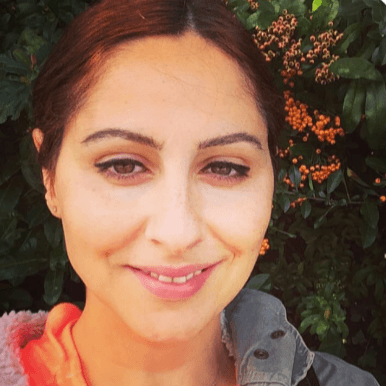
Jul 18, 2024
|
12 min read
Enhance your IT analyst resume: Tips to spotlight your skills, tools to highlight your technical prowess.
Rated by 348 people
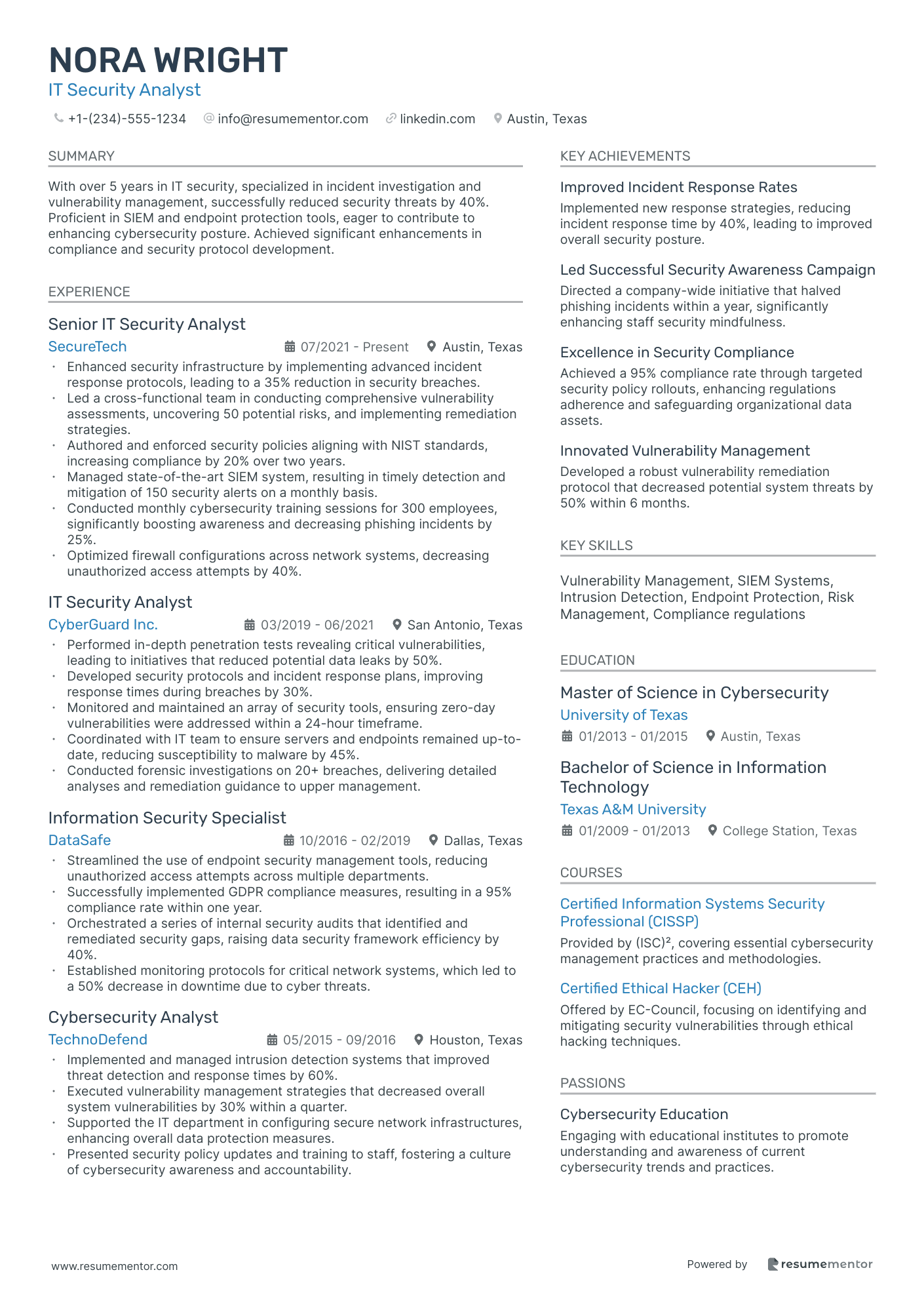
IT Security Analyst
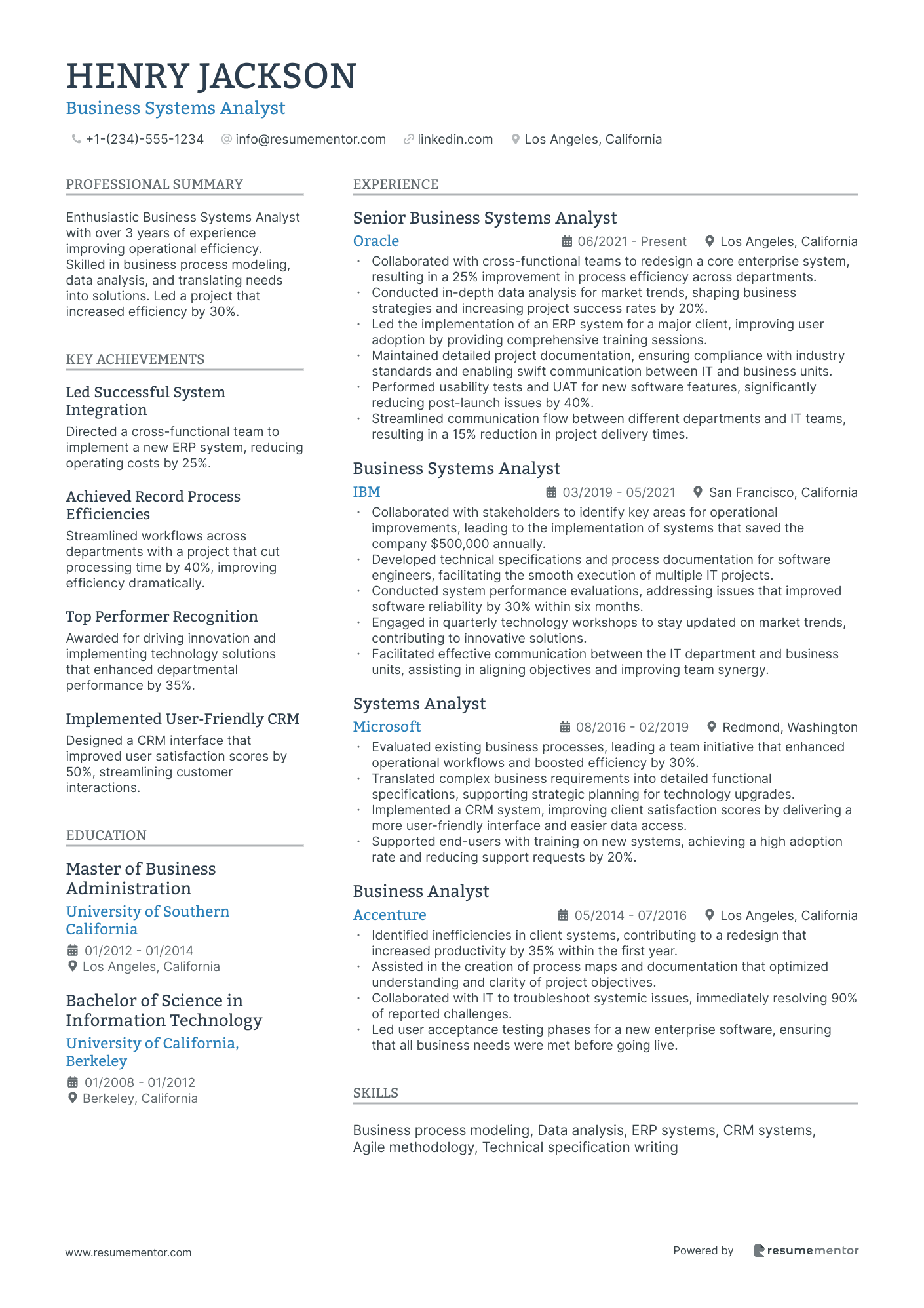
Business Systems Analyst
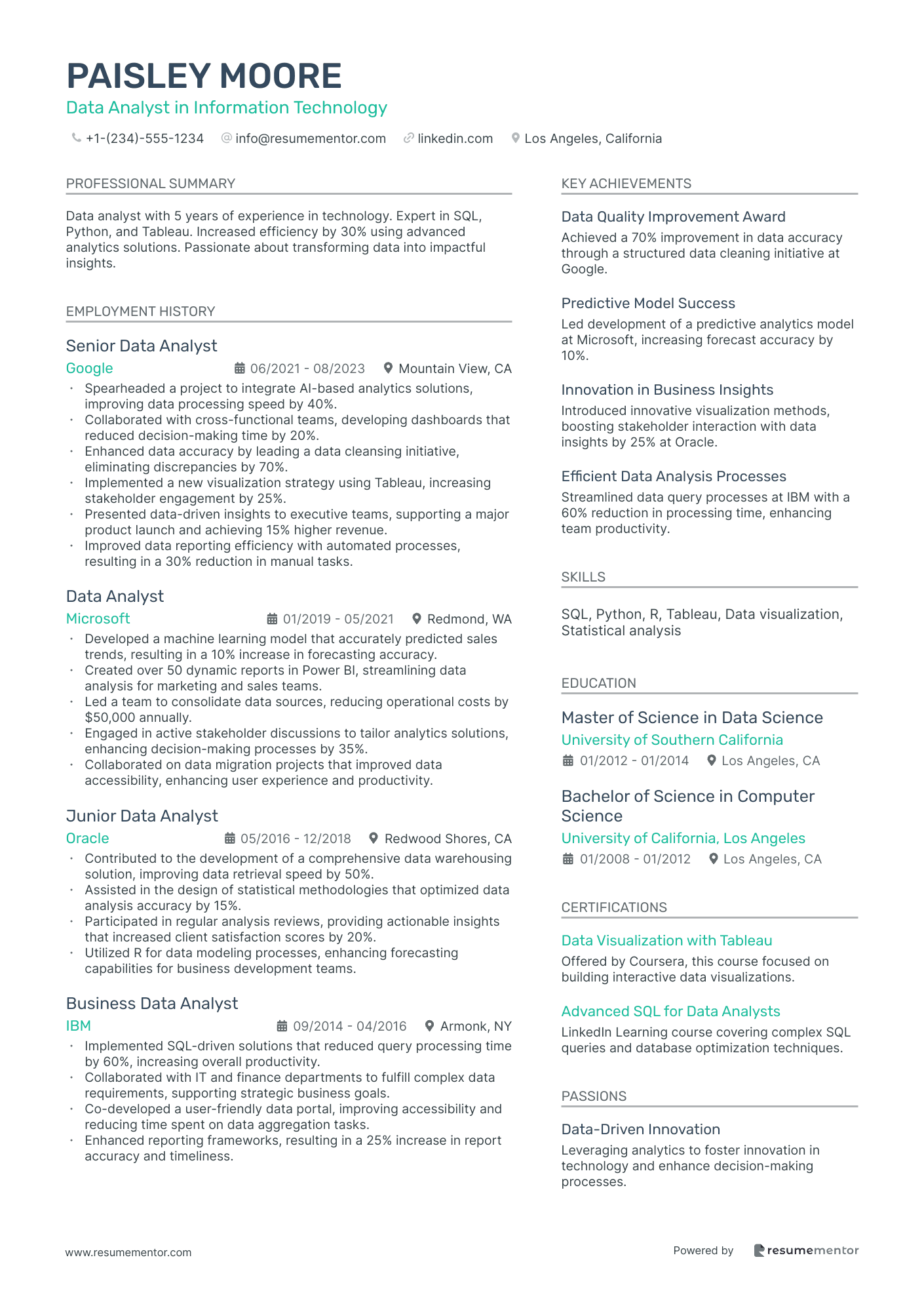
Data Analyst in Information Technology
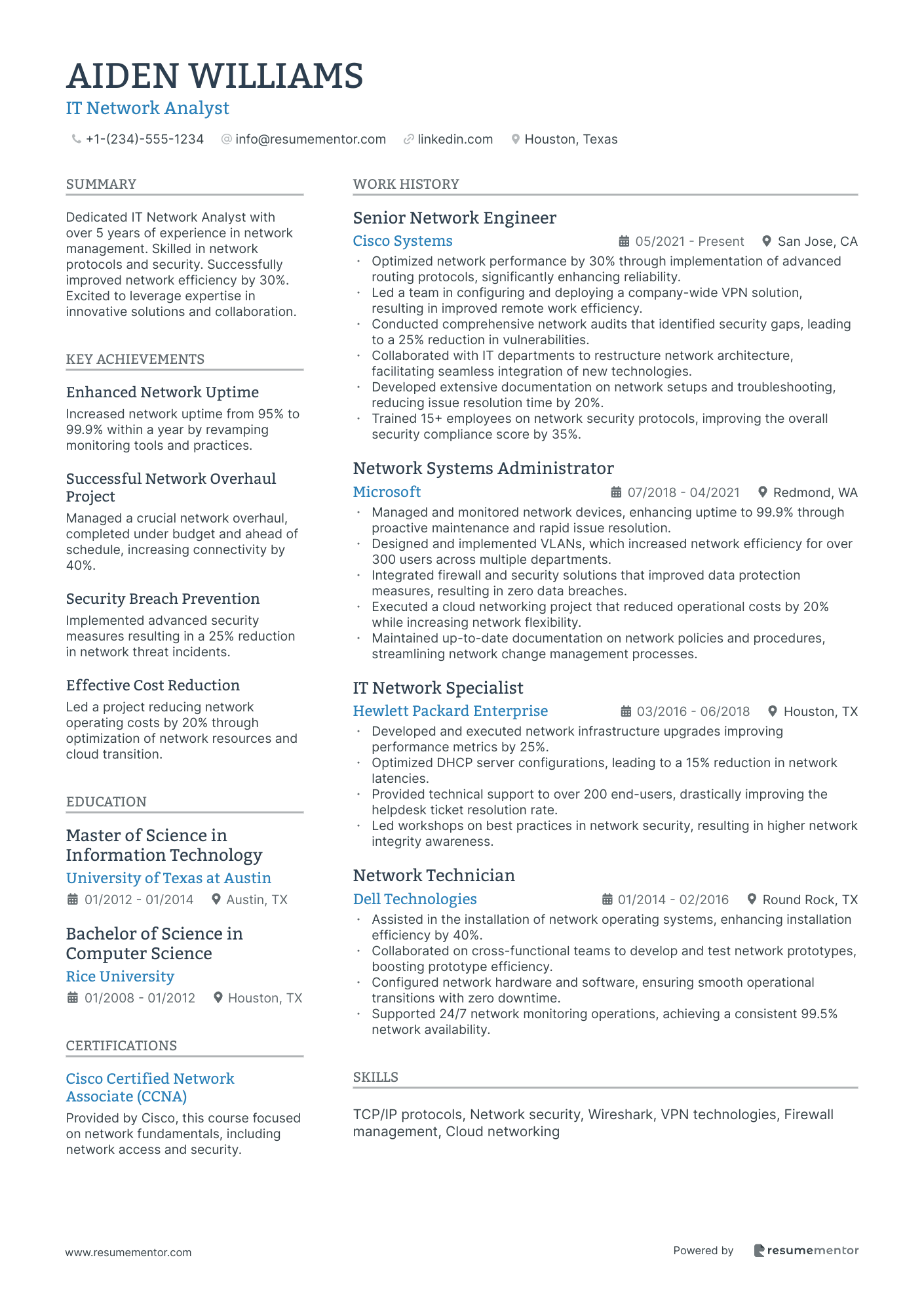
IT Network Analyst
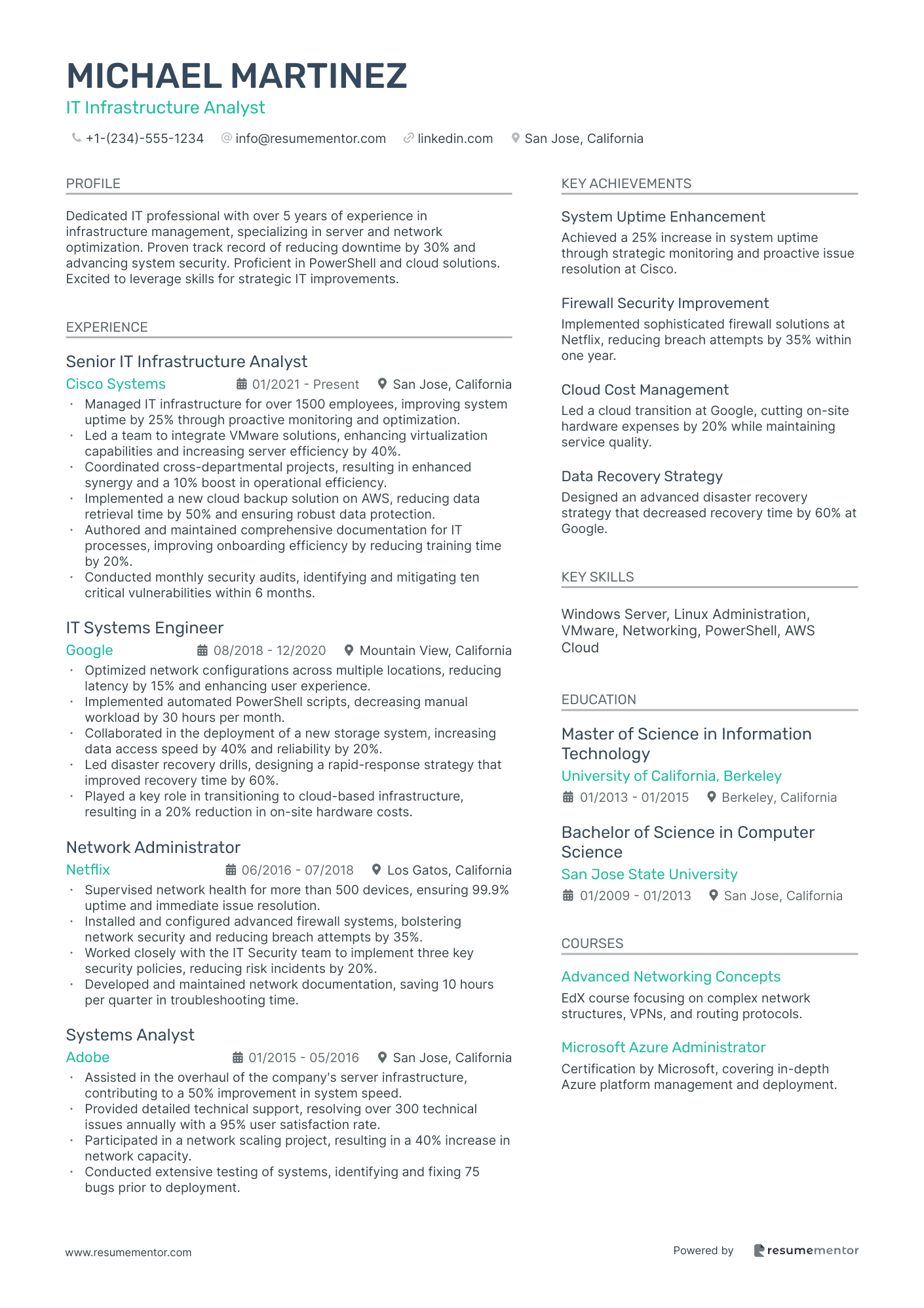
IT Infrastructure Analyst
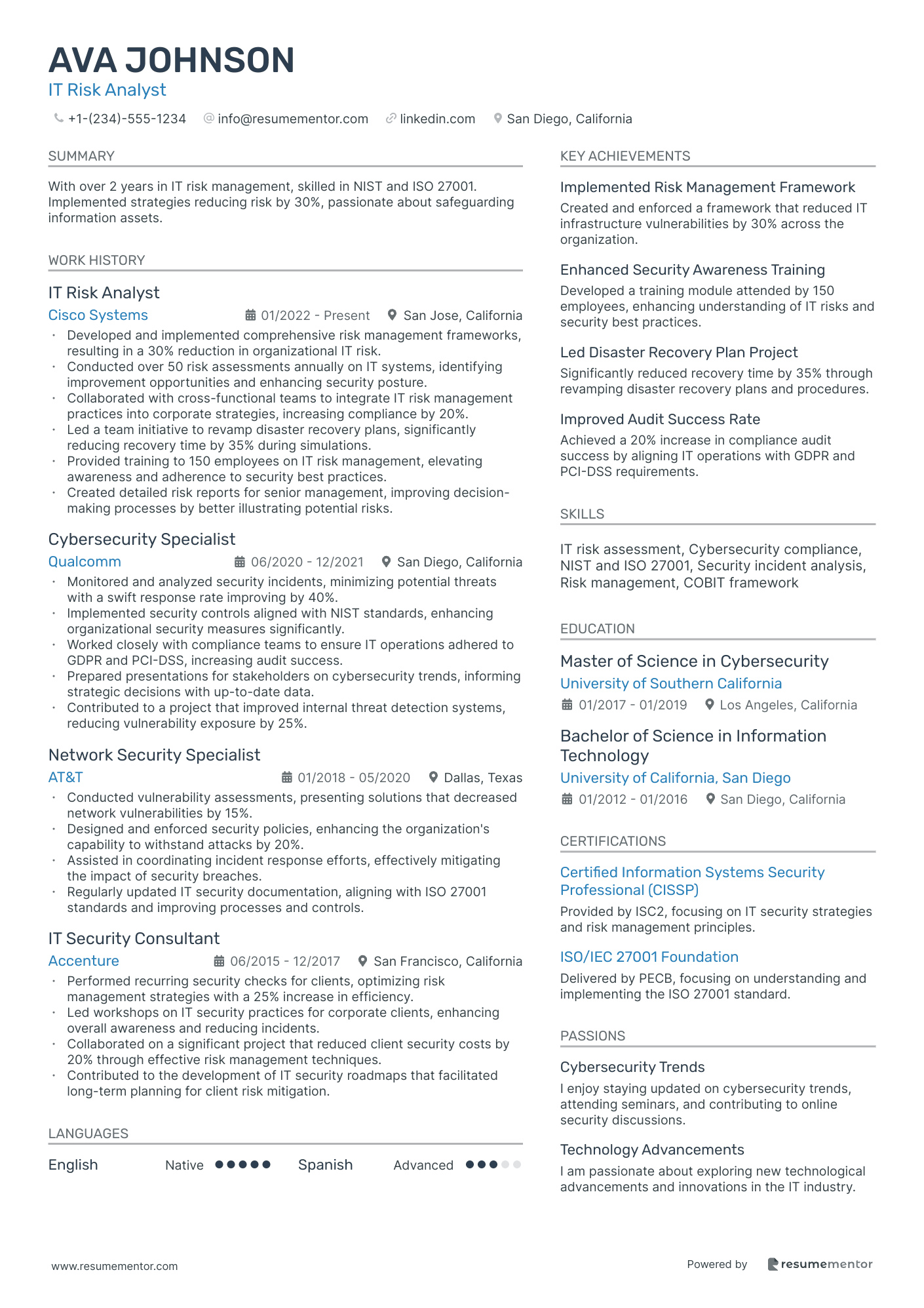
IT Risk Analyst

Software Quality Assurance Analyst
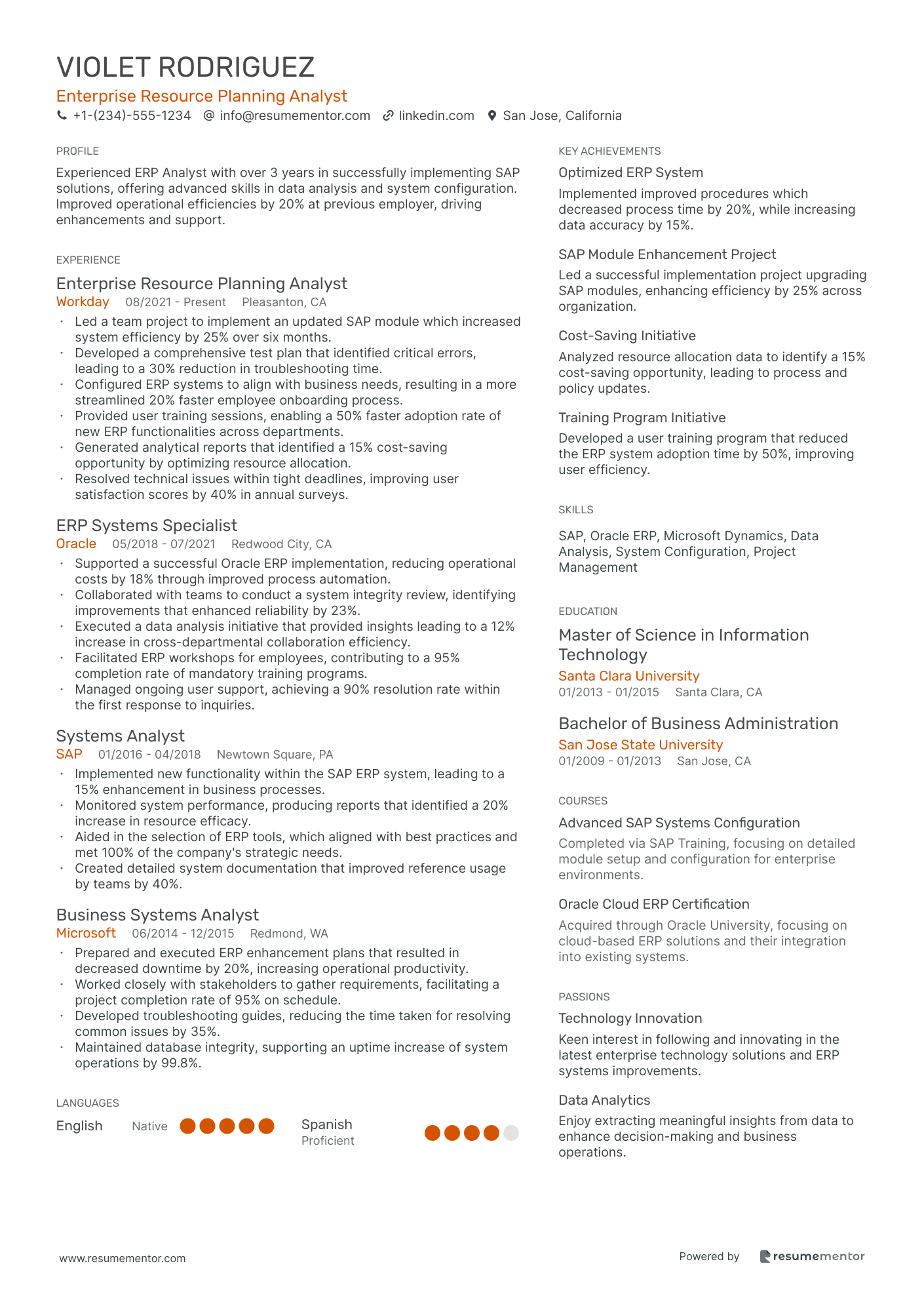
Enterprise Resource Planning Analyst
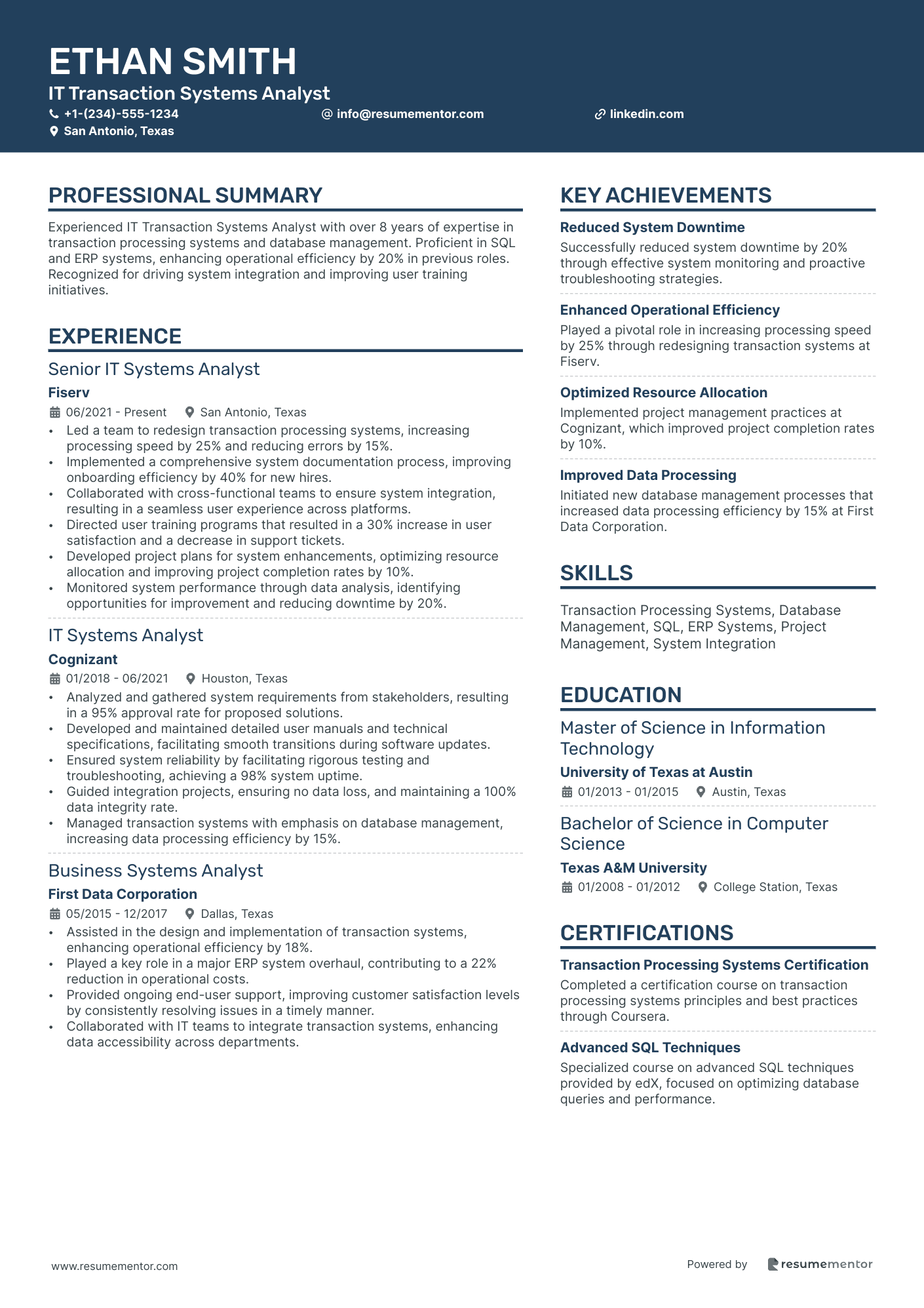
IT Transaction Systems Analyst
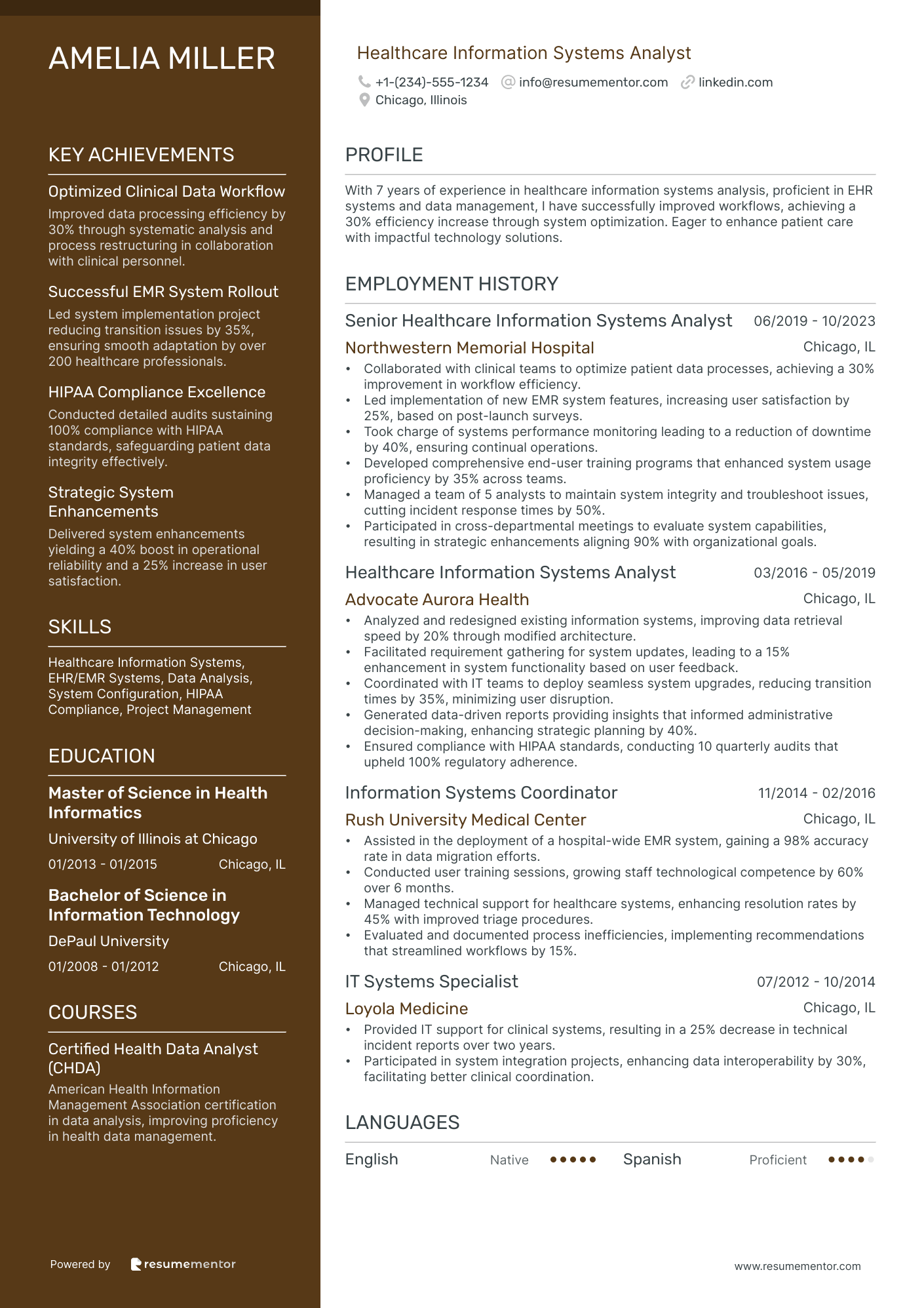
Healthcare Information Systems Analyst

IT Security Analyst resume sample
- •Enhanced security infrastructure by implementing advanced incident response protocols, leading to a 35% reduction in security breaches.
- •Led a cross-functional team in conducting comprehensive vulnerability assessments, uncovering 50 potential risks, and implementing remediation strategies.
- •Authored and enforced security policies aligning with NIST standards, increasing compliance by 20% over two years.
- •Managed state-of-the-art SIEM system, resulting in timely detection and mitigation of 150 security alerts on a monthly basis.
- •Conducted monthly cybersecurity training sessions for 300 employees, significantly boosting awareness and decreasing phishing incidents by 25%.
- •Optimized firewall configurations across network systems, decreasing unauthorized access attempts by 40%.
- •Performed in-depth penetration tests revealing critical vulnerabilities, leading to initiatives that reduced potential data leaks by 50%.
- •Developed security protocols and incident response plans, improving response times during breaches by 30%.
- •Monitored and maintained an array of security tools, ensuring zero-day vulnerabilities were addressed within a 24-hour timeframe.
- •Coordinated with IT team to ensure servers and endpoints remained up-to-date, reducing susceptibility to malware by 45%.
- •Conducted forensic investigations on 20+ breaches, delivering detailed analyses and remediation guidance to upper management.
- •Streamlined the use of endpoint security management tools, reducing unauthorized access attempts across multiple departments.
- •Successfully implemented GDPR compliance measures, resulting in a 95% compliance rate within one year.
- •Orchestrated a series of internal security audits that identified and remediated security gaps, raising data security framework efficiency by 40%.
- •Established monitoring protocols for critical network systems, which led to a 50% decrease in downtime due to cyber threats.
- •Implemented and managed intrusion detection systems that improved threat detection and response times by 60%.
- •Executed vulnerability management strategies that decreased overall system vulnerabilities by 30% within a quarter.
- •Supported the IT department in configuring secure network infrastructures, enhancing overall data protection measures.
- •Presented security policy updates and training to staff, fostering a culture of cybersecurity awareness and accountability.
Business Systems Analyst resume sample
- •Collaborated with cross-functional teams to redesign a core enterprise system, resulting in a 25% improvement in process efficiency across departments.
- •Conducted in-depth data analysis for market trends, shaping business strategies and increasing project success rates by 20%.
- •Led the implementation of an ERP system for a major client, improving user adoption by providing comprehensive training sessions.
- •Maintained detailed project documentation, ensuring compliance with industry standards and enabling swift communication between IT and business units.
- •Performed usability tests and UAT for new software features, significantly reducing post-launch issues by 40%.
- •Streamlined communication flow between different departments and IT teams, resulting in a 15% reduction in project delivery times.
- •Collaborated with stakeholders to identify key areas for operational improvements, leading to the implementation of systems that saved the company $500,000 annually.
- •Developed technical specifications and process documentation for software engineers, facilitating the smooth execution of multiple IT projects.
- •Conducted system performance evaluations, addressing issues that improved software reliability by 30% within six months.
- •Engaged in quarterly technology workshops to stay updated on market trends, contributing to innovative solutions.
- •Facilitated effective communication between the IT department and business units, assisting in aligning objectives and improving team synergy.
- •Evaluated existing business processes, leading a team initiative that enhanced operational workflows and boosted efficiency by 30%.
- •Translated complex business requirements into detailed functional specifications, supporting strategic planning for technology upgrades.
- •Implemented a CRM system, improving client satisfaction scores by delivering a more user-friendly interface and easier data access.
- •Supported end-users with training on new systems, achieving a high adoption rate and reducing support requests by 20%.
- •Identified inefficiencies in client systems, contributing to a redesign that increased productivity by 35% within the first year.
- •Assisted in the creation of process maps and documentation that optimized understanding and clarity of project objectives.
- •Collaborated with IT to troubleshoot systemic issues, immediately resolving 90% of reported challenges.
- •Led user acceptance testing phases for a new enterprise software, ensuring that all business needs were met before going live.
Data Analyst in Information Technology resume sample
- •Spearheaded a project to integrate AI-based analytics solutions, improving data processing speed by 40%.
- •Collaborated with cross-functional teams, developing dashboards that reduced decision-making time by 20%.
- •Enhanced data accuracy by leading a data cleansing initiative, eliminating discrepancies by 70%.
- •Implemented a new visualization strategy using Tableau, increasing stakeholder engagement by 25%.
- •Presented data-driven insights to executive teams, supporting a major product launch and achieving 15% higher revenue.
- •Improved data reporting efficiency with automated processes, resulting in a 30% reduction in manual tasks.
- •Developed a machine learning model that accurately predicted sales trends, resulting in a 10% increase in forecasting accuracy.
- •Created over 50 dynamic reports in Power BI, streamlining data analysis for marketing and sales teams.
- •Led a team to consolidate data sources, reducing operational costs by $50,000 annually.
- •Engaged in active stakeholder discussions to tailor analytics solutions, enhancing decision-making processes by 35%.
- •Collaborated on data migration projects that improved data accessibility, enhancing user experience and productivity.
- •Contributed to the development of a comprehensive data warehousing solution, improving data retrieval speed by 50%.
- •Assisted in the design of statistical methodologies that optimized data analysis accuracy by 15%.
- •Participated in regular analysis reviews, providing actionable insights that increased client satisfaction scores by 20%.
- •Utilized R for data modeling processes, enhancing forecasting capabilities for business development teams.
- •Implemented SQL-driven solutions that reduced query processing time by 60%, increasing overall productivity.
- •Collaborated with IT and finance departments to fulfill complex data requirements, supporting strategic business goals.
- •Co-developed a user-friendly data portal, improving accessibility and reducing time spent on data aggregation tasks.
- •Enhanced reporting frameworks, resulting in a 25% increase in report accuracy and timeliness.
IT Network Analyst resume sample
- •Optimized network performance by 30% through implementation of advanced routing protocols, significantly enhancing reliability.
- •Led a team in configuring and deploying a company-wide VPN solution, resulting in improved remote work efficiency.
- •Conducted comprehensive network audits that identified security gaps, leading to a 25% reduction in vulnerabilities.
- •Collaborated with IT departments to restructure network architecture, facilitating seamless integration of new technologies.
- •Developed extensive documentation on network setups and troubleshooting, reducing issue resolution time by 20%.
- •Trained 15+ employees on network security protocols, improving the overall security compliance score by 35%.
- •Managed and monitored network devices, enhancing uptime to 99.9% through proactive maintenance and rapid issue resolution.
- •Designed and implemented VLANs, which increased network efficiency for over 300 users across multiple departments.
- •Integrated firewall and security solutions that improved data protection measures, resulting in zero data breaches.
- •Executed a cloud networking project that reduced operational costs by 20% while increasing network flexibility.
- •Maintained up-to-date documentation on network policies and procedures, streamlining network change management processes.
- •Developed and executed network infrastructure upgrades improving performance metrics by 25%.
- •Optimized DHCP server configurations, leading to a 15% reduction in network latencies.
- •Provided technical support to over 200 end-users, drastically improving the helpdesk ticket resolution rate.
- •Led workshops on best practices in network security, resulting in higher network integrity awareness.
- •Assisted in the installation of network operating systems, enhancing installation efficiency by 40%.
- •Collaborated on cross-functional teams to develop and test network prototypes, boosting prototype efficiency.
- •Configured network hardware and software, ensuring smooth operational transitions with zero downtime.
- •Supported 24/7 network monitoring operations, achieving a consistent 99.5% network availability.
IT Infrastructure Analyst resume sample
- •Managed IT infrastructure for over 1500 employees, improving system uptime by 25% through proactive monitoring and optimization.
- •Led a team to integrate VMware solutions, enhancing virtualization capabilities and increasing server efficiency by 40%.
- •Coordinated cross-departmental projects, resulting in enhanced synergy and a 10% boost in operational efficiency.
- •Implemented a new cloud backup solution on AWS, reducing data retrieval time by 50% and ensuring robust data protection.
- •Authored and maintained comprehensive documentation for IT processes, improving onboarding efficiency by reducing training time by 20%.
- •Conducted monthly security audits, identifying and mitigating ten critical vulnerabilities within 6 months.
- •Optimized network configurations across multiple locations, reducing latency by 15% and enhancing user experience.
- •Implemented automated PowerShell scripts, decreasing manual workload by 30 hours per month.
- •Collaborated in the deployment of a new storage system, increasing data access speed by 40% and reliability by 20%.
- •Led disaster recovery drills, designing a rapid-response strategy that improved recovery time by 60%.
- •Played a key role in transitioning to cloud-based infrastructure, resulting in a 20% reduction in on-site hardware costs.
- •Supervised network health for more than 500 devices, ensuring 99.9% uptime and immediate issue resolution.
- •Installed and configured advanced firewall systems, bolstering network security and reducing breach attempts by 35%.
- •Worked closely with the IT Security team to implement three key security policies, reducing risk incidents by 20%.
- •Developed and maintained network documentation, saving 10 hours per quarter in troubleshooting time.
- •Assisted in the overhaul of the company's server infrastructure, contributing to a 50% improvement in system speed.
- •Provided detailed technical support, resolving over 300 technical issues annually with a 95% user satisfaction rate.
- •Participated in a network scaling project, resulting in a 40% increase in network capacity.
- •Conducted extensive testing of systems, identifying and fixing 75 bugs prior to deployment.
IT Risk Analyst resume sample
- •Developed and implemented comprehensive risk management frameworks, resulting in a 30% reduction in organizational IT risk.
- •Conducted over 50 risk assessments annually on IT systems, identifying improvement opportunities and enhancing security posture.
- •Collaborated with cross-functional teams to integrate IT risk management practices into corporate strategies, increasing compliance by 20%.
- •Led a team initiative to revamp disaster recovery plans, significantly reducing recovery time by 35% during simulations.
- •Provided training to 150 employees on IT risk management, elevating awareness and adherence to security best practices.
- •Created detailed risk reports for senior management, improving decision-making processes by better illustrating potential risks.
- •Monitored and analyzed security incidents, minimizing potential threats with a swift response rate improving by 40%.
- •Implemented security controls aligned with NIST standards, enhancing organizational security measures significantly.
- •Worked closely with compliance teams to ensure IT operations adhered to GDPR and PCI-DSS, increasing audit success.
- •Prepared presentations for stakeholders on cybersecurity trends, informing strategic decisions with up-to-date data.
- •Contributed to a project that improved internal threat detection systems, reducing vulnerability exposure by 25%.
- •Conducted vulnerability assessments, presenting solutions that decreased network vulnerabilities by 15%.
- •Designed and enforced security policies, enhancing the organization's capability to withstand attacks by 20%.
- •Assisted in coordinating incident response efforts, effectively mitigating the impact of security breaches.
- •Regularly updated IT security documentation, aligning with ISO 27001 standards and improving processes and controls.
- •Performed recurring security checks for clients, optimizing risk management strategies with a 25% increase in efficiency.
- •Led workshops on IT security practices for corporate clients, enhancing overall awareness and reducing incidents.
- •Collaborated on a significant project that reduced client security costs by 20% through effective risk management techniques.
- •Contributed to the development of IT security roadmaps that facilitated long-term planning for client risk mitigation.
Software Quality Assurance Analyst resume sample
- •Developed and maintained over 500 test cases, enhancing testing coverage by 30% and ensuring comprehensive application validation.
- •Collaborated with development teams to improve software features, resulting in a 20% increase in user satisfaction ratings over eight months.
- •Led the evaluation of automated testing tools, contributing to a 15% reduction in test execution time by implementing Selenium-based frameworks.
- •Played a pivotal role in sprint planning and daily stand-ups, facilitating the identification and resolution of over 200 defects in a year.
- •Executed both manual and automated testing procedures for new product releases, reducing post-launch defects by 25% across multiple projects.
- •Maintained detailed records of test outcomes, ensuring transparent communication and remediation processes across cross-functional teams.
- •Documented and executed test scripts for enterprise applications, contributing to a defect reduction rate of 35% over two product cycles.
- •Worked closely with Agile teams, actively participating in sprint retrospectives to enhance testing practices and development processes.
- •Implemented regression tests that preserved 98% of existing functionalities during updates, significantly minimizing user-reported issues.
- •Tested software performance and compatibility across diverse platforms, enhancing overall product stability and customer trust.
- •Assisted in refining QA processes, leading to an efficiency improvement of 20% in test preparation and execution time.
- •Created detailed test documentation supporting software releases, resulting in a 15% reduction of post-release bugs.
- •Utilized JIRA for tracking software defects, streamlining communication with developers and boosting resolution time by 40%.
- •Conducted manual testing sessions that improved application responsiveness, receiving positive feedback from 90% of end users.
- •Contributed to cross-team efforts that boosted overall software delivery speed by integrating continuous testing methods.
- •Executed thorough testing procedures on new software applications, detecting critical bugs before production release.
- •Crafted clear and precise test cases that improved the initial test coverage by 25%, supporting quality deliverables.
- •Communicated effectively with developers, helping to mitigate software defects early in the development lifecycle.
- •Played a significant role in early stages of the project life cycle, leading to decreased QA bottlenecks at later stages.
Enterprise Resource Planning Analyst resume sample
- •Led a team project to implement an updated SAP module which increased system efficiency by 25% over six months.
- •Developed a comprehensive test plan that identified critical errors, leading to a 30% reduction in troubleshooting time.
- •Configured ERP systems to align with business needs, resulting in a more streamlined 20% faster employee onboarding process.
- •Provided user training sessions, enabling a 50% faster adoption rate of new ERP functionalities across departments.
- •Generated analytical reports that identified a 15% cost-saving opportunity by optimizing resource allocation.
- •Resolved technical issues within tight deadlines, improving user satisfaction scores by 40% in annual surveys.
- •Supported a successful Oracle ERP implementation, reducing operational costs by 18% through improved process automation.
- •Collaborated with teams to conduct a system integrity review, identifying improvements that enhanced reliability by 23%.
- •Executed a data analysis initiative that provided insights leading to a 12% increase in cross-departmental collaboration efficiency.
- •Facilitated ERP workshops for employees, contributing to a 95% completion rate of mandatory training programs.
- •Managed ongoing user support, achieving a 90% resolution rate within the first response to inquiries.
- •Implemented new functionality within the SAP ERP system, leading to a 15% enhancement in business processes.
- •Monitored system performance, producing reports that identified a 20% increase in resource efficacy.
- •Aided in the selection of ERP tools, which aligned with best practices and met 100% of the company's strategic needs.
- •Created detailed system documentation that improved reference usage by teams by 40%.
- •Prepared and executed ERP enhancement plans that resulted in decreased downtime by 20%, increasing operational productivity.
- •Worked closely with stakeholders to gather requirements, facilitating a project completion rate of 95% on schedule.
- •Developed troubleshooting guides, reducing the time taken for resolving common issues by 35%.
- •Maintained database integrity, supporting an uptime increase of system operations by 99.8%.
IT Transaction Systems Analyst resume sample
- •Led a team to redesign transaction processing systems, increasing processing speed by 25% and reducing errors by 15%.
- •Implemented a comprehensive system documentation process, improving onboarding efficiency by 40% for new hires.
- •Collaborated with cross-functional teams to ensure system integration, resulting in a seamless user experience across platforms.
- •Directed user training programs that resulted in a 30% increase in user satisfaction and a decrease in support tickets.
- •Developed project plans for system enhancements, optimizing resource allocation and improving project completion rates by 10%.
- •Monitored system performance through data analysis, identifying opportunities for improvement and reducing downtime by 20%.
- •Analyzed and gathered system requirements from stakeholders, resulting in a 95% approval rate for proposed solutions.
- •Developed and maintained detailed user manuals and technical specifications, facilitating smooth transitions during software updates.
- •Ensured system reliability by facilitating rigorous testing and troubleshooting, achieving a 98% system uptime.
- •Guided integration projects, ensuring no data loss, and maintaining a 100% data integrity rate.
- •Managed transaction systems with emphasis on database management, increasing data processing efficiency by 15%.
- •Assisted in the design and implementation of transaction systems, enhancing operational efficiency by 18%.
- •Played a key role in a major ERP system overhaul, contributing to a 22% reduction in operational costs.
- •Provided ongoing end-user support, improving customer satisfaction levels by consistently resolving issues in a timely manner.
- •Collaborated with IT teams to integrate transaction systems, enhancing data accessibility across departments.
- •Evaluated and improved transaction processing systems, leading to a 20% increase in operational speed.
- •Documented and analyzed business requirements, ensuring systems met all regulatory compliance needs.
- •Monitored system performance metrics, recommending changes that resulted in a 15% improvement in system reliability.
- •Collaborated with business units to create detailed specifications, reducing project inconsistencies by 10%.
Healthcare Information Systems Analyst resume sample
- •Collaborated with clinical teams to optimize patient data processes, achieving a 30% improvement in workflow efficiency.
- •Led implementation of new EMR system features, increasing user satisfaction by 25%, based on post-launch surveys.
- •Took charge of systems performance monitoring leading to a reduction of downtime by 40%, ensuring continual operations.
- •Developed comprehensive end-user training programs that enhanced system usage proficiency by 35% across teams.
- •Managed a team of 5 analysts to maintain system integrity and troubleshoot issues, cutting incident response times by 50%.
- •Participated in cross-departmental meetings to evaluate system capabilities, resulting in strategic enhancements aligning 90% with organizational goals.
- •Analyzed and redesigned existing information systems, improving data retrieval speed by 20% through modified architecture.
- •Facilitated requirement gathering for system updates, leading to a 15% enhancement in system functionality based on user feedback.
- •Coordinated with IT teams to deploy seamless system upgrades, reducing transition times by 35%, minimizing user disruption.
- •Generated data-driven reports providing insights that informed administrative decision-making, enhancing strategic planning by 40%.
- •Ensured compliance with HIPAA standards, conducting 10 quarterly audits that upheld 100% regulatory adherence.
- •Assisted in the deployment of a hospital-wide EMR system, gaining a 98% accuracy rate in data migration efforts.
- •Conducted user training sessions, growing staff technological competence by 60% over 6 months.
- •Managed technical support for healthcare systems, enhancing resolution rates by 45% with improved triage procedures.
- •Evaluated and documented process inefficiencies, implementing recommendations that streamlined workflows by 15%.
- •Provided IT support for clinical systems, resulting in a 25% decrease in technical incident reports over two years.
- •Participated in system integration projects, enhancing data interoperability by 30%, facilitating better clinical coordination.
As an IT analyst, navigating the job market can feel like diving into a complex data set. You have the skills and the ability to solve problems, but transforming these into an engaging resume can be daunting. It's crucial to convey your analytical prowess and technical expertise in a way that stands out to employers.
To catch their eye, your resume should seamlessly combine deep technical knowledge with your broad problem-solving abilities. From handling system architecture to managing intricate projects, it's important to show how you convert technical insights into actionable solutions. Presenting this information clearly and concisely allows your strengths to shine through.
A resume template can simplify this process, helping you organize your accomplishments and skills without getting tangled in formatting. This structure not only highlights your achievements but also lets you focus on tailoring the content to reflect your unique strengths.
Think of your resume as a snapshot of your career—a story of how you bridge the gap between data and decision-making. With the right presentation, your resume becomes a powerful tool that opens the door to new opportunities.
In this guide, you'll learn to craft a resume that confidently reflects your strengths as an IT analyst. Let's build a resume that captures the essence of your expertise and propels your career forward.
Key Takeaways
- Emphasizing analytical prowess and technical expertise is crucial in creating a standout IT analyst resume, where showcasing problem-solving abilities and technical insights is key.
- Organizing accomplishments within a structured resume template helps focus on unique strengths and allows recruiters to see the value an applicant brings effectively.
- A reverse-chronological resume format with modern fonts and PDF formatting highlights current skills and preserves document integrity across devices.
- Quantifiable experience descriptions using strong action verbs and specific outcomes vividly narrate past professional achievements.
- The education and certification sections should be tailored to reflect relevant qualifications that align with the job requirements and industry expectations.
What to focus on when writing your IT analyst resume
Your IT analyst resume should convey to the recruiter that you have a strong foundation in problem-solving skills and expertise in data analysis and information systems. This should highlight how you enhance technology solutions and improve efficiencies across projects.
How to structure your IT analyst resume
- Contact Information — Your contact information is crucial for establishing communication. Make sure to provide your full name, phone number, email address, and LinkedIn profile. Using a professional email address can make a positive impression. A LinkedIn profile that matches your resume details will reinforce your professional brand.
- Professional Summary — This section serves as your elevator pitch. Offer a concise but compelling snapshot of your experience and skills. Highlight how you apply these skills to optimize IT systems and support data-driven business decisions. This summary should entice recruiters to read further by aligning with the key demands of the IT analyst role.
- Technical Skills — The technical skills section acts as evidence of your abilities in the IT realm. Don’t just list generic skills; specify tools and technologies like SQL, data analytics software, and project management platforms such as JIRA that showcase your technical prowess. Tailor this section to the job description to show you meet the employer's needs.
- Work Experience — Narrate your past roles and accomplishments to paint a picture of your career progression. Highlight achievements that demonstrate your ability to improve business operations, manage databases, or lead impactful IT projects. Use metrics where possible to quantify your contributions and make them more tangible.
- Education — Your educational background supports your claim to expertise. Detail your degree in Information Technology or a related field, and emphasize certifications like CompTIA, CCNA, or ITIL. These credentials affirm your technical knowledge and professional commitment.
- Projects — This section is where you showcase your real-world problem-solving skills. Highlight IT projects or systems you've successfully led or contributed to, focusing on the results and the value you delivered. This provides evidence of your capability to drive successful outcomes within teams.
After understanding these sections, it's essential to consider resume format to ensure all elements come together seamlessly—below, we'll cover each section more in-depth.
Which resume format to choose
As an IT analyst, choosing the right resume format is essential for effectively highlighting your skills in the tech industry. A reverse-chronological format not only showcases your most recent and relevant experience but also aligns with the fast-paced and detail-oriented nature of IT roles. This format helps potential employers quickly assess your current skills and contributions, providing a clear picture of how you can impact their team.
Pair this format with a modern font such as Rubik, Lato, or Montserrat. These fonts offer a fresh and professional appearance, which can enhance the readability of your resume and convey a sense of modernity and innovation that aligns with the tech sector. Avoid older, more common fonts like Arial or Times New Roman, which may not resonate with the cutting-edge environment you wish to portray.
Make sure to save and send your resume as a PDF. This file type ensures that your carefully formatted resume looks the same on all devices and software, preventing any layout shifts that could detract from a polished first impression. In a tech-savvy industry, demonstrating attention to detail in how you present your resume reflects your professionalism and technical acumen.
Lastly, maintain one-inch margins on all sides of your document. This creates a clean, open look that enhances readability and presents your information in a well-organized manner. Well-structured content ensures your skills and experiences are easily accessible, making it simpler for potential employers to glean the information they need.
By focusing on these elements, you can craft a resume that not only effectively represents your experience but also captures the attention of hiring managers within the competitive IT industry.
How to write a quantifiable resume experience section
In an IT analyst resume, the experience section is crucial in painting a vivid picture of your professional journey for potential employers. It’s not just about listing past roles, but about communicating the impact you’ve had through quantifiable achievements. Start by listing your most recent role at the top, going backward, and include relevant experiences from the last 10 to 15 years to keep the information pertinent. Tailoring your resume for each job application involves highlighting experiences and skills that directly match the job description, ensuring your career story is engaging and aligned. Begin each bullet point with dynamic action verbs like "improved," "managed," "developed," or "analyzed" to immediately showcase your contributions and value.
- •Enhanced system efficiency by 25% through data analysis and process improvements.
- •Spearheaded a project introducing a new CRM system that boosted customer satisfaction by 30%.
- •Analyzed data to uncover trends that led to $200K in annual savings through cost-saving opportunities.
- •Directed user training sessions, improving technology adoption rates by 40% in six months.
This example effectively ties your achievements to your role, creating a cohesive narrative of your impact at Tech Solutions Inc. It begins with a concise overview of your responsibilities, setting the stage for the detailed achievements that follow. Each bulleted point flows naturally from the last, thanks to the use of strong verbs and specific results, painting a clear picture of your contributions. This approach seamlessly aligns your past successes with what potential employers are seeking, allowing them to quickly see the value you would bring to their team.
Achievement-Focused resume experience section
A results-driven IT Analyst resume experience section should highlight your significant contributions and the impacts you've had in previous roles. Start by emphasizing key achievements, detailing how you improved processes, resolved complex issues, or successfully completed projects that align with the IT Analyst role. This approach helps potential employers easily identify the value you can bring to their team.
To make your successes stand out, provide context by including specific metrics or details that showcase your work's scope and impact. Use clear action verbs to tie your achievements together in a meaningful way. This cohesive narrative demonstrates not just your capabilities, but also how your efforts made a real difference to the organizations you were a part of.
IT Analyst
June 2020 - Present
- Led a team of five to rebuild a customer service platform, reducing response time by 30%.
- Developed an automated reporting tool to cut errors by 40%.
- Collaborated with a cross-functional team on a system upgrade, enhancing data security by 25%.
- Initiated a knowledge-sharing program, training 15 junior analysts and boosting team efficiency by 20%.
Innovation-Focused resume experience section
An innovation-focused IT Analyst resume experience section should emphasize the creative impact of your contributions. Begin by listing your job title, workplace, and employment dates, setting the stage for what follows. Use bullet points to detail successful projects or inventive solutions you’ve spearheaded, illustrating how these efforts spurred positive changes. With action verbs and quantifiable metrics, clearly convey the impact of your achievements.
Reveal how you pinpointed opportunities for innovation by sharing concrete examples where your analytical skills led to groundbreaking projects or process enhancements. Highlight collaborations with various teams and any leadership roles you assumed to underscore your ability to innovate and make a difference. This strategy effectively demonstrates the unique value you bring to potential employers.
IT Analyst
Tech Innovators Inc.
January 2020 - Present
- Led a cross-functional team to develop a new data analysis tool, improving processing speed by 40%.
- Implemented a system upgrade that reduced downtime by over 30% and enhanced user experience.
- Drove a project to integrate AI solutions, boosting data accuracy rates by 25%.
- Worked with stakeholders to identify and resolve system bottlenecks, enhancing efficiency.
Skills-Focused resume experience section
A skills-focused IT Analyst resume experience section should clearly highlight your technical and analytical abilities in an engaging way. Start by selecting experiences that showcase how you've effectively used your skills in real-world situations. Each bullet point should hone in on a specific skill critical for the role, while demonstrating your impact through measurable outcomes like improved efficiency or cost savings. By using strong action verbs, you can convey a sense of responsibility and initiative, making your achievements stand out.
Consider the skills most important for the job you're targeting and ensure each bullet point reflects how you solve problems, manage technology, and collaborate with team members. Keep your statements straightforward and powerful, as hiring managers may only have a few seconds to scan each resume. Ensuring each bullet point hits the mark can capture their attention quickly and effectively.
IT Analyst
Tech Solutions Inc.
June 2020 - Present
- Enhanced data processing speed by 30% through system optimization strategies.
- Developed user manuals for a new software application, increasing user adoption by 25%.
- Collaborated with cross-functional teams to troubleshoot and resolve database issues, reducing downtime by 15%.
- Implemented a security patch strategy that reduced vulnerabilities by 40%.
Training and Development Focused resume experience section
A Training and Development-focused IT Analyst resume experience section should highlight your skills in assessing training needs and crafting effective solutions. Start by listing each relevant job, focusing on roles where your analytical abilities led to improvements in training programs. Explain how you identified issues or inefficiencies and the strategies you implemented to address them, showcasing your role in enhancing team abilities and refining processes. This demonstrates how your insights supported the company’s objectives.
Organize your achievements using bullet points to ensure clarity. Each bullet should start with an action verb, adding vitality to your descriptions. Focus on outcomes that illustrate the tangible impact of your efforts, such as enhanced team performance or streamlined training processes. By quantifying your achievements, you provide strong evidence of your expertise. This approach effectively communicates your capacity to drive successful training outcomes as an IT Analyst.
IT Analyst
Tech Innovators Inc.
March 2021 - Present
- Developed a comprehensive training program that increased team efficiency by 25%.
- Analyzed training data to identify gaps, providing customized solutions that improved learning retention by 30%.
- Collaborated with cross-functional teams to implement an automated training scheduling system, reducing administrative workload by 15%.
- Led workshops on new software tools, resulting in a 40% reduction in technical support queries.
Write your IT analyst resume summary section
A results-focused IT Analyst resume summary should captivate employers by clearly conveying your unique value. This pivotal section should string together your skills and achievements to set you apart. If you possess years of experience, your summary must showcase your expertise and notable successes. Evidently, highlighting specific tools, technologies, and projects will create alignment with the desired role. Here’s how a compelling IT analyst resume summary could look:
This example weaves together your experience and skills, crafting a narrative that highlights your readiness to contribute meaningfully. It underscores your impact, making you an attractive candidate. For those on the cusp of their careers, especially recent graduates, consider an objective to better articulate your aspirations. Flagging qualities like motivation and attention to detail conveys potential quickly. Enabling your enthusiasm for the industry to permeate this section could make it engaging. Each word matters, so use them wisely and steer clear of empty clichés. Moreover, distinguishing between resume sections boosts your application. While a summary underscores experience, an objective focuses on your career ambitions. Meanwhile, a resume profile tends to be less detailed, and a summary of qualifications lists key skills. As you tailor each section to the specific job, prioritize what the employer seeks. Honest, well-crafted writing significantly heightens your interview chances, so let your experience guide your decision between using a summary, objective, or another section type.
Listing your IT analyst skills on your resume
A skills-focused IT analyst resume should emphasize how your abilities make you a strong candidate for the role. You can choose to spotlight your skills in a standalone section or integrate them into other areas like your experience and summary. This flexibility lets you decide the best way to highlight your natural strengths, such as your knack for problem-solving and adaptability, alongside specific technical skills needed for the job.
Skills don't just show what you can do; they also serve as essential keywords in your resume. The right keywords can make your application stand out to potential employers and pass through applicant tracking systems (ATS) effectively. Including them correctly can significantly increase your chances of securing an interview.
Here's an example of a standalone skills section in JSON format, demonstrating why it’s effective:
This skills section is successful because it clearly presents technical competencies relevant to IT analysts, making your qualifications easy to understand quickly.
Best hard skills to feature on your IT analyst resume
For IT analysts, hard skills should showcase your technical expertise and detail how you handle data and systems. These skills need to demonstrate your ability to tackle technical tasks while supporting business goals.
Hard Skills
- Business Analysis
- Data Analysis
- SQL Programming
- Systems Analysis
- Process Mapping
- Network Configuration
- Database Management
- Cybersecurity
- Requirements Gathering
- Software Testing
- IT Infrastructure
- Project Management
- Cloud Computing
- Technical Writing
- User Support
Best soft skills to feature on your IT analyst resume
The soft skills of an IT analyst are essential as they highlight interpersonal abilities and professionalism. They illustrate how you can collaborate, adapt, and creatively solve problems in a team.
Soft Skills
- Communication
- Problem-solving
- Teamwork
- Adaptability
- Critical Thinking
- Time Management
- Attention to Detail
- Leadership
- Conflict Resolution
- Decision-making
- Emotional Intelligence
- Creativity
- Persuasion
- Multitasking
- Active Listening
How to include your education on your resume
The education section of your resume is a key component for any aspiring IT analyst. This section communicates your academic qualifications and should be tailored to match the job requirements. Only include education that is relevant to the position you're applying for. If your GPA is strong, include it to enhance your application; list it alongside your degree with a format like: "3.8/4.0." When graduating with honors like cum laude, mention it next to your degree, such as "BSc in Computer Science, cum laude." Ensure each degree is clearly stated, including your field of study, institution, and graduation date.
Here's an incorrect example:
Now, a correct example, geared for an IT analyst role:
This example is effective because it highlights a degree relevant to IT analysis and showcases a high GPA, indicating a strong academic performance. Tailoring your education section allows you to present your qualifications in a way that aligns with the job you're pursuing.
How to include IT analyst certificates on your resume
Including a certificates section in your IT analyst resume is crucial. A well-documented certificates section showcases your specialized skills and ongoing professional development. To create this section, list the name of the certificate, include the date of issuance, and add the issuing organization.
You can also feature key certificates in your resume header to grab attention. For example, if you have a CISSP certification, you might highlight it as follows: "Jane Doe, CISSP, IT Analyst". This immediately communicates your qualifications to employers.
Here is a good example of a standalone certificates section:
This example is effective because it features certifications highly relevant to IT analysts. Each item clearly provides the certificate's name, the issuing organization, and shows these are recognized authorities in the field. This boosts your credibility and shows your commitment to your career.
Extra sections to include in your IT analyst resume
A career as an IT Analyst offers exciting opportunities to work with cutting-edge technologies and solve complex problems. To stand out in this field, it's important to craft a resume that highlights not only your technical skills but also your diverse experiences and interests.
Language section — State the languages you speak to show your ability to work in a global environment. Highlighting this can make you a more attractive candidate for roles involving international teams.
Hobbies and interests section — Share your hobbies to give employers a glimpse into your personality and potential team fit. Including this can make you more relatable and memorable.
Volunteer work section — Detail your volunteer experiences to demonstrate commitment and leadership in your community. This shows you possess qualities like empathy and initiative, which are valuable in any role.
Books section — List books that have influenced your professional development to showcase your continuous learning. This can highlight your dedication to staying up-to-date in your field.
In Conclusion
In conclusion, creating a compelling IT analyst resume involves strategically highlighting your abilities and achievements in a way that captures a potential employer's attention. Your resume is more than just a list of past jobs; it's a story about how your skills have made a difference. Starting with a clear professional summary can set the tone by encapsulating your experience and expertise concisely. Make sure each section, whether it be your education, experience, or certifications, aligns with the technical demands and soft skills crucial for IT roles. Prioritize clarity and relevance, especially when detailing technical skills or listing projects, as these sections provide evidence of your capability to drive results. In terms of presentation, the format should be clean and modern, ensuring that your achievements shine through without distraction. Using tools like resume templates can assist in keeping your formatting professional. Your resume not only highlights your qualifications but also demonstrates your professionalism and attention to detail. Lastly, remember that a well-rounded resume sometimes includes extras like language proficiencies, volunteer work, or even hobbies to portray your unique personality. By thoughtfully combining these elements, you position yourself as a standout candidate ready to make an impact.
Related Articles

Continue Reading
Check more recommended readings to get the job of your dreams.
Resume
Resources
Tools
© 2025. All rights reserved.
Made with love by people who care.

